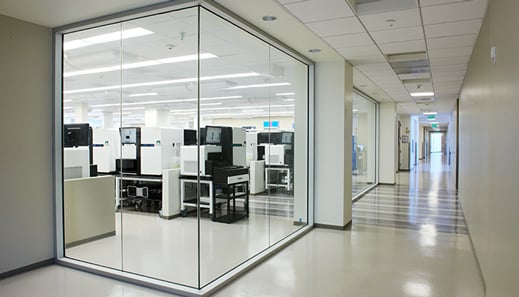Inside Illumina’s Plans to Lure Consumers with an App Store for Genomes
The CEO of the world’s leading DNA sequencing company says he knows how to finally get consumers interested in their genomes: by creating an enormous app store for genetic information.

Yesterday, Illumina said that along with Warburg Pincus and Sutter Hill Ventures it was investing $100 million in a new company called Helix to make consumer genomics part of the Internet mainstream.
Illumina’s CEO, Jay Flatley, said in an interview that Helix will subsidize the cost of decoding people’s genomes in hopes of spurring the creation of consumer apps that will draw on the DNA data repeatedly. “You saw what happened with the Apple app store: it just unleashed the consumer side because apps are so cheap to make,” says Flatley, who will be chairman of the new company.
Flatley says that when Helix goes live next year it will sequence and store consumers’ DNA, then sell them pay-as-you-go access to it through the apps, which will be offered by partners, the first of which are LabCorp and the Mayo Clinic. Profits will get shared, in a model similar to the one for Apple’s app store. If Helix succeeds, it will operate the largest sequencing laboratory of any kind, Flatley predicts.
Everyone is trying to unlock the value of the genome, most of all Illumina (see “50 Smartest Companies 2014”). The San Diego-based company, whose sleek-looking sequencing machines are also said to be inspired by Apple’s designs, is the big winner so far. It dominates the market and last year sold $1.8 billion of DNA sequencing machines, chemicals, and tests. The more sequencing happens, the better for Illumina.
Right now, genome sequencing is done by research laboratories, at hospitals, and even by a few national programs. The formation of Helix is about the last big uncracked market: you and me.
So far, interest by consumers in genomics has been fairly tepid. Who do you know whose genome has been sequenced? The problem is that for healthy people, the genome just isn’t that important. What does it mean? What is it good for? Even though sequencing a genome has become much cheaper, just a couple of thousand dollars, to most people, finding out isn’t worth the cost. Even Flatley, whose genome is sequenced and posted to the Internet, has called the experience ho-hum.

So how do you get consumers to participate? The idea behind Helix is to make it pay-as-you-go.
Here’s how it might work. Say you download an app from a Helix partner to find out if you have a specific genetic variant, for example the “speed gene,” known to be possessed by many athletes (nicely described here by 23andMe). And imagine that app costs $20. You send in a spit sample; Helix will return just that information to you through the app.
But Helix will sequence much more of your genome, says Flatley. He says Helix will do “an exome plus”—that is, decode all your genes and a few more key spots, but not parts of the genome without clear medical relevance. That will cost Helix perhaps $500. But then, if you order a new app that draws on your genes, Helix will already have your DNA information, ready to be quickly served up.
“We are betting on the consumer coming back and asking for more, and then you don’t have to sequence a second time,” says Flatley. In contrast, if you wanted to sign up for both Ancestry.com and 23andMe, two different companies offering genetic genealogy, you’d have to get tested twice.
Flatley says Helix will be a “neutral” player, storing DNA and serving it up to any app on the platform. Like Apple’s app store, which takes a 30 percent cut of every copy of Angry Birds that is sold, revenue will be shared by Helix and by app makers, although Flatley didn’t say what the percentages would be. He did describe one important twist: whichever affiliate (say, the Mayo Clinic) first convinces a consumer to send in a spit sample will also get paid each time that person’s genome is accessed again, by any other app.
That’s basically a bounty for dragging people into the genome age.
The whole setup turns on convincing consumers to sign on. Flatley says the market has proved that consumers will part with only around $99 for DNA information, say for a genealogy test. The pay-as-you-go model is a way to bridge the difference between that and the higher cost of sequencing. “It’s got to be a no-brainer price tag. You make it a no-brainer purchase for the consumer,” says Flatley.
Storing thousands or millions of genomes could also put Helix in a good position as biologists make more discoveries about what genetic information is good for. “As the science gets better and better the content is going to be better, and the consumer will be charged for that,” says Flatley.
The idea behind Helix is pretty cool—your genome in the cloud somewhere, accessed by snazzy apps. But there are downsides. You are buying into the idea that genes are destiny. And privacy? Helix will be “incredibly secure,” says Flatley. But let’s not forget the main objective here: to get you, the consumer, to willingly expose your DNA to commercial apps just as you hand over your location or address book.
Illumina’s prior foray into apps wasn’t a big success. It launched a system called BaseSpace—an app store for researchers—that didn’t really take off. Scientists tell me it does a little of everything, but nothing very well.
But times change. Now everyone is anticipating an explosion of consumer activity around genomics, cloud computing, and apps (see “Google Wants to Store Your Genome” and “Apple Has Plans for Your DNA”).
To succeed, Helix may need a killer app, the kind a person can’t stop checking on the bus or in the elevator. Flatley admits he’s not yet sure what such an app would do. “An objective is to stimulate that large developer community, and get more people focused on it and discover what that killer app might be,” he says.
The Mayo Clinic is working on one app related to educating people about DNA, the organization confirmed, and Flatley says other early apps could be “educational, to do with nutrition, or sports-related.” It sounds like lightweight stuff. There are reasons for that. To dispense real diagnostic information an app maker would probably need approval from the U.S. Food and Drug Administration—something that would take time to obtain. Flatley says he’s been talking to the FDA about Helix.
Right now, the most important consumer-facing uses of genetics are in cancer predisposition testing, genealogy, and carrier screening. The genealogy tests tell you to whom you are related, your ethnic origins, and how much Neanderthal DNA you have. Carrier screening is about what’s next: when you are ready to have a baby, you can check whether you and your partner share dangerous disease mutations. Companies offering these types of consumer tests, such as 23andMe and Counsyl, have spent millions building out labs, analytical software, or just paying Illumina to analyze the DNA.
With Helix, says Flatley, companies won’t have to invest in starting a laboratory anymore. Instead, he says, any developer with a computer will be able to start a genomics company.
Keep Reading
Most Popular
Large language models can do jaw-dropping things. But nobody knows exactly why.
And that's a problem. Figuring it out is one of the biggest scientific puzzles of our time and a crucial step towards controlling more powerful future models.
The problem with plug-in hybrids? Their drivers.
Plug-in hybrids are often sold as a transition to EVs, but new data from Europe shows we’re still underestimating the emissions they produce.
How scientists traced a mysterious covid case back to six toilets
When wastewater surveillance turns into a hunt for a single infected individual, the ethics get tricky.
Google DeepMind’s new generative model makes Super Mario–like games from scratch
Genie learns how to control games by watching hours and hours of video. It could help train next-gen robots too.
Stay connected
Get the latest updates from
MIT Technology Review
Discover special offers, top stories, upcoming events, and more.